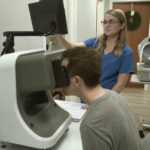Sponsored Content

By Matt Dixon, OD
July 14, 2021
During a time when we are spending more time than ever online, eye strain and headaches are an increasingly common patient complaint. Multiple clinical studies have shown that these symptoms are often attributed to the effects of eye misalignment, particularly exacerbated by extended near vision utilization.
Fortunately, in my practice, I have a spectacle lens system, neurolens, informed by the neurolens Measurement Device, Gen 2—or nMD2—that is changing how I help patients with symptoms that can range from persistent and uncomfortable to debilitating. Here are the details on how neurolens is helping my patients find relief and a higher quality of life, as well as improving the financial performance of my practice.
Huge Practice Booster
I implemented neurolens in my practice in 2018, and since that time the system has grown in use with our patients. In the first four months of 2021, optical revenue was up 77 percent against 2019. Sales of neurolenses, excluding the frame, represent 26 percent of that revenue and a significant percentage of overall optical profits. Nothing else we’ve done has had this level of impact.
Despite reservations, we found that neurolens has been an easy addition to our practice. The start-up costs are small compared to other technology purchases. The nMD2 device is similar to an autorefractor in size and does not require a separate room, special lighting or any other special accommodations. The staff training time is minimal. A large number of symptomatic patients are already walking through the typical optometry practice’s doors daily. ROI is tremendous. We easily recouped our investment within eight months and began profiting from it after that point.
It’s worth noting that neurolenses are not covered by any vision discount plans. This is yet another reason neurolens is such a financial winner for practices. The huge discounts and controls imposed on our profession by vision plans are perhaps the most challenging aspect of running a profitable optical retail center. To offer a compelling optical solution with high patient demand without any imposed discounts is rare in our industry. In the case of neurolens, patients are highly motivated to spend out-of-pocket because of the life-changing benefits it offers. And the guaranteed outcome makes it a no-risk decision for the patient.
Take a “Playbook” Approach
We have a “playbook” approach that works really well. We ask each patient at the time of their exam to fill out a symptom questionnaire. Symptoms of trigeminal dysphoria go beyond headaches and include light sensitivity, dizziness, dry eye and neck stiffness. Up to 75 percent of our patients experience many of these. Based on their responses and our criteria for classifying them as symptomatic, we obtain an accurate measurement of their degree of misalignment on the nMD2 prior to seeing the doctor. The quick and objective findings allow the doctor to easily match the symptoms with a detailed measurement of misalignment at distance and near. The report includes a precise recommendation for the amount of contoured prism, which the doctor can then include in their prescription. A standard prism Rx simply cannot achieve the same level of symptom resolution.

A patient is screened on the new neurolens nMD2 measurement device, which ensures more accurate-than-ever measurements to correct eye misalignment.
Once the measurement is completed, I ask the patient to give a brief description of their typical day and how the symptoms impact them. We avoid yes/no questions such as, “Are you having any trouble with your eyes?” I have found that it’s better to allow the patient to tell their story free from leading questions, then authentically let them know how we can help.
From there, the doctor explains how small misalignments cause neural symptoms and how neurolens can resolve virtually every symptom. The treatment plan is repeated in front of the patient to the optician during the optical hand-off, and the optician begins by repeating the plan by saying, “I’ll be sure that we take care of all of these issues, and I know you’re going to love your new glasses!”
Educate Patients, But Don’t Overwhelm
My style is not to over-explain. I prefer to keep the conversation brief to prevent “TMI.” I occasionally use diagrams or other graphics based on the individual. I tell the patient, “Our eye muscles can work really hard all day long without getting tired or fatigued. However, for many of us, when we spend too much time converging or crossing our eyes to see up close, the brain becomes over-stimulated and that is the reason for all the symptoms.” I may use the term trigeminal dysphoria if I get the sense that the patient is more clinically inclined.
Importantly, I frequently share a testimonial video from one of my own patients who has had tremendous success.
In addition, we use brochures provided by neurolens and I compare neurolens to other treatments. Many have already tried medications, massages and other therapies, so they are open to a novel approach, especially one that is specifically addressing the root cause and is 100 percent guaranteed.
Learn More
Learn more about how neurolens can change the lives of your patients and propel your practice to greater growth and profitability.
We have all seen an increase in digital device use over the past year among patients of all ages. We are all more engaged virtually for education, work and personal connections. Patients who were already symptomatic are now experiencing even greater impact as the volume of hours spent doing near work has greatly increased. I often hear that my patients can spend 12-16 hours a day on their devices, and in fact a 2020 study from UnitedHealthcare suggests that average daily digital device usage has increased to over 13 hours.
Most patients don’t realize that eye misalignment may be making their eye strain and headaches worse, and that glasses with contoured prism can provide significant relief, enabling them to increase their comfort and quality of life.
Other Articles to Explore
No Shortage of Patients Who Can Benefit
With up to 75 percent of patients who walk into our practice having symptoms of trigeminal dysphoria—including dry eye symptoms—there are no shortage of potential candidates for neurolens in every optometric office.
The dramatic difference that neurolens can make in our patients’ lives and the impact on profitability makes neurolens an investment that is a true winner for both patients and practice.
 Matt Dixon, OD, is the owner of Advanced Eyecare Center in Perry, Ga. To contact him: drmattdixon@gmail.com
Matt Dixon, OD, is the owner of Advanced Eyecare Center in Perry, Ga. To contact him: drmattdixon@gmail.com

























